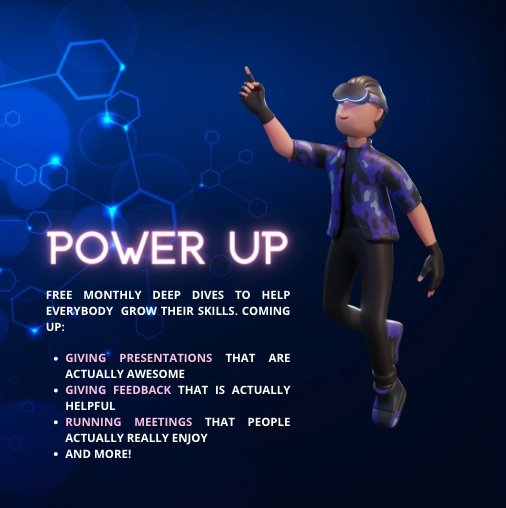16 ways to encourage employees to attend training
Thinking like a marketer is important for driving attendance.
So, you’ve designed a brilliant training programme for your organisation, full of exciting learning opportunities, training courses and other useful elements. Well done you!
But even though your training design is totally on-point, you’ll still need to provide extra encouragement for employees to actually attend.
Why might staff not attend training courses?
Many people might feel like they’re ‘too busy’, and not sure whether it should be prioritised over their existing workload. Others may incorrectly assume they’re outside the target audience, imagining that they’re too junior to be eligible, or too senior for the training to be valuable.
Some staff may prove quite resistant to, or sceptical of, the value of training, feeling confident that they ‘know it all already’, concerned that attending might imply they don’t know what they’re doing, or perhaps left unimpressed by a previous sub-par training experience elsewhere.
So it’s time to put your internal marketing hat on, and run some communication designed to overcome these fears, blockers and obstacles. Here are our top tips for getting employees at your workplace to attend training courses.
1. Connect the training to recent or upcoming events at your workplace
The underlying purpose for the training might be obvious to you – after all, there’s probably a reason you booked the training you did! – but it doesn’t hurt to connect the dots for potential attendees. Whether it’s new challenges at work, recurring themes from employee engagement surveys, or a recent shift in working patterns, make it clear that the training is designed to meet a real need, ideally one that staff themselves have previously raised.
2. Position training as ‘additional knowhow’ rather than ‘a major correction’
When it comes to learning opportunities, potential attendees may become defensive if they detect an insinuation of incompetence, i.e. “You’re doing a bad job at X, so now you have to go on this training course.”
Instead, connect training to people’s passions, goals or challenges, and assume they’re already giving it everything they’ve got: “I know you’ve been keen to develop your expertise at X recently, so I thought you might find some really interesting ideas in this training course.”
Of course, a training course should ultimately inspire attendees to change the way they do things, but the point is that most people don’t think of themselves as Bad at Stuff – they’d rather be considered ‘pretty good, but excited to get even better.’ So match this in your messaging.
This is also important for topics like diversity & inclusion: almost nobody likes to think of themselves as prejudiced or cliquey, so training is best positioned towards the better angels of their nature. “We know how deeply many of you are committed to making Acme Inc. a welcoming and inclusive place to work, which is why…”
3. Pair training with other interventions to meet your organisational goals
It makes perfect sense to use learning & development to address deep challenges, but employees will want to know your organisation is taking a multi-faceted approach to key issues.
For instance, if a department is feeling totally swamped with work, and staff feel like your ‘one big solution’ is being ‘sent on a time management course’, the reaction might be decidedly unenthusiastic. In fact, staff might feel that by attending, they are tacitly conceding that the problem is ‘all them’ rather than a more complex corporate issue.
However, if you can highlight a range of actions your company is taking to address workload, including training busy staff to more ruthlessly prioritise and defend their calendars, the training will feel more like part a holistic response.
4. Give your training courses meaningful names
The titles you give your training activities internally don’t need to be the exact same as the courses you commission from your training provider.
For example, you might specifically name sessions with the same competencies that you use in role descriptions and career pathways. That way, it’s simple for employees to understand that ‘Training Course X’ will help them acquire a specific skill they need for the next step in their professional journey.
Similarly, think about how you can brand your overall training offering or programme to sound aspirational, exciting and ambitious.
5. Build an internal brand for learning & development
As well as naming sessions, create materials and internal communications with a bit of visual verve using tools like Canva. Design a memorable and consistent ‘look’ for your training promotion that inspires people to attend and creates a sense of something bigger than an individual training session.
6. Track attendance, and reward it (the right way)
Try to reward employees for attending and learning from training with professional recognition, not unrelated incentives.
Create a record, or use your existing HRIS system, of who attends which training course. Attending training (and being able to show how it’s enhanced their work!) should be a key way for staff to demonstrate their commitment and increasing skills when it comes to performance or pay reviews, for example.
Informally, be sure to celebrate the people and teams who are making great use of all the learning & development opportunities at your workplace.
However, you’ll sometimes see people suggest that you use more arbitary incentives to encourage participation, like prizes. And sure, if you need to quickly push colleagues through some deeply necessary but tooth-grindingly dull training for compliance purposes, this might be appropriate. But in general, offering ‘bribes’ to participate in training undercuts the case that the courses will be enjoyable and valuable in their own right. Taking part in an inspiring training session, learning new things and unlocking possibilities for career progression should provide sufficient intrinsic reward that extrinsic motivators aren’t necessary, or are even actively unhelpful.
7. Collect feedback, tweak your training, and share the love
It goes without saying that you’ll want to collect feedback from your staff on the training they attend, to ensure it’s meeting their needs. (Here at BiteSize Learning, we’re constantly fine-tuning our courses based on helpful suggestions from our training participants.)
Not only will the feedback give you an opportunity to address any weaknesses and improve the training for future cohorts, it should also give you a smorgasbord of praise and positive comments you can use to support your internal marketing of upcoming sessions.
8. Connect training with your organisation’s values and employer brand
The most important thing is to avoid the sense that training is a chore, obligation, or worst of all: a punishment! Instead, you’ll want to position all your learning & development as a perk and part of your organisation’s commitment to its employees. Some important brand values it might connect with:
Providing progression: you see the potential in every member of staff, and want to give people as many routes as possible to do their best work.
Developing everyone for the future: even if people move on from your organisation at some point, you want everyone to leave your company smarter and more skilled than when they joined, so their time with you has been a valuable learning experience.
Supporting staff to overcome obstacles: it’s not enough to identify areas for improvement during a performance management process. But when you’re providing the right training, you’re also providing staff with solutions, not just problems. This in turn makes negative feedback less scary, if it’s likely to be paired with an opportunity to grow.
Wellbeing and mental health: sure, the connection with training specifically about wellbeing is obvious, but a wide range of other training topics contribute to happier, high-welfare workplaces. For instance, training in managing difficult conversations, managing upwards, or successful teamwork, all contribute to creating a more candid, honest and empathetic workplace where people know where they stand and feel comfortable speaking up. This in turn develops a greater sense of psychological safety in employees, which is crucial in reducing anxiety and burnout.
Inclusion: similarly, it’s obvious why D&I training helps develop inclusive workplaces, but a bold commitment to learning & development in general will level the playing field internally in other ways. Giving all employees access to high-quality training helps drive internal career mobility and enable you to recruit and promote more inclusively.
Curiosity and open-mindedness: training, especially in partnership with external providers, can send the message that your organisation is never complacent or thinks it knows it all, and is genuinely excited to learning new things and discover even better ways of working together. In turn, this creates a healthier workplace culture where people are unafraid to admit what they don’t know and willing to gently challenge the status quo.
9. Involve senior leaders in your training
It’s worth ensuring that staff at all levels of the company engage with your training programme. If senior leadership is totally absent, for example, it sends the message that attending training is not considered high-status behaviour, or only for people that “can’t get out of doing it”, and ambitious people will subconsciously start to avoid taking part.
For some targeted initiatives, like a new graduate programme, senior participation is obviously unnecessary, but for voluntary or company-wide offers, getting high-level leaders to visibly attend training shows that nobody is too important or too experienced to learn something new.
This might be particularly meaningful for training around cultural issues, such as diversity or mental health, where change needs to be embraced (and seen to be embraced) ‘from the top.’ And because these individuals tend to have large internal audiences (such as the departments they lead) they have strong opportunities to broadcast their involvement widely, share personal reflections on their reactions and highlight how the training benefited them.
(Conversely, there may be a few scenarios where it’s counter-productive to invite senior staff to the same sessions as junior employees. For instance, some sessions might invite attendees to discuss their work challenges openly, and some will feel more hesitant to speak freely in front of the CEO.)
10. Get people to share what they learned with colleagues
There’s often not capacity for everyone to attend every training offer – you can turn this to your advantage.
Firstly, get managers to ask attendees to summarise their learnings for their teammates, reserving them an agenda slot in the following week’s team meeting for example. This massively incentivises staff to prioritise attending, and in the session, they’ll pay attention more closely, looking for valuable nuggets of knowledge that they’d like to pass on.
Teaching others is a proven method of embedding learning, so when the time comes to report back, recapping their experience will help make the learning stick for the attendee, while amplifying the reach of these new ideas throughout your organisation. For the attendee’s colleagues, it gives a taste of what they were missing out on, and encourages them to attend future training sessions on other topics.
Finally, this dynamic is a great way to overcome know-it-allness: some staff can be encouraged by managers to attend training for the (alleged) primary purpose of information gathering for their teammates, while their own personal development is a surprise side-effect on the day. For some, helping others or representing a team is a deeper motivator than personal benefit.
11. Embrace scarcity to increase percieved value
If you’re bringing exciting live training sessions into your organisation, there probably isn’t room for everyone to attend. And that’s OK: you can use this to emphasise the limited number of seats available, and encourage people to sign up at the earliest opportunity! Or, if you’re handpicking attendees, you can use this framing to underscore that being chosen to participate is a privileged opportunity.
12. Make training important and secure commitment
Training courses might seem like a bit of a luxury next to the demanding day-to-day of an employee’s worklife. So make sure you underline that an RSVP is a real commitment rather than a soft ‘I’ll make it if I can!’ response. Equally, be clear that attendees need to fully engage with the session, especially if it’s taking place online, rather than juggling their video call among other tasks and browser tabs. Send people calendar invites, reminders to attend, and if someone doesn’t show up, don’t be afraid to investigate why and gently call them out if necessary.
13. Work with your managers
It’s crucial that team managers are aligned with your message. For instance, you’ll need them to back up the idea that it’s OK for team members to attend and fully focus on training sessions, even during a busy day, and that they’ll in fact take a dim view of no-showing!
Ask managers to model good behaviour by leading the way in attending training and reporting back, co-ordinating attendance from their teams, and directing particular employees to particularly helpful training sessions during 1:1s or performance discussions.
While it may be wise to maintain a supremely-confident ‘nearly sold out!’ attitude in your company-wide communications, be more candid with senior managers to identify gaps in attendance, emphasise the resources that have gone into creating everything, and how they can help improve attendance.
14. Make learning part of everyday work
People are more likely to take training seriously if learning feels like a normal part of their job - not an extra task they have to squeeze in! Get managers to lead by example. Encourage them to talk about what they’ve learned, share insights in team meetings, and support people in applying new skills. If training is expected, not optional, attendance won’t be a struggle.
15. Remove barriers to attending
Even the best training won’t work if people don’t have time for it. If sessions clash with deadlines or feel like a low priority, attendance will drop. Offer flexible options - shorter sessions, on-demand content, or dedicated time for learning. Make it easy for people to say “yes” instead of “I’d love to, but I’m too busy.”
16. Make some noise!
Finally, remember that more is more. Think about all your internal communications: all-hands & town halls, weekly emails, internal calendars, recurring team meetings, conversations on Slack & Teams, automated updates from your HR platform, even external platforms like LinkedIn.
Consider all the key channels your company uses and the cadence at which communication occurs, and work to include learning & development and training promotion in as many as possible. Be consistent, be persistent – and have fun!











![[Guide] Handling conflict at work: what good managers do differently](https://images.squarespace-cdn.com/content/v1/6348398d9d21fd6277c64f96/1764074828110-OAKDWQ3PJ3E0VQ4BAE84/blog+images+June+2025+%2820%29.png)

